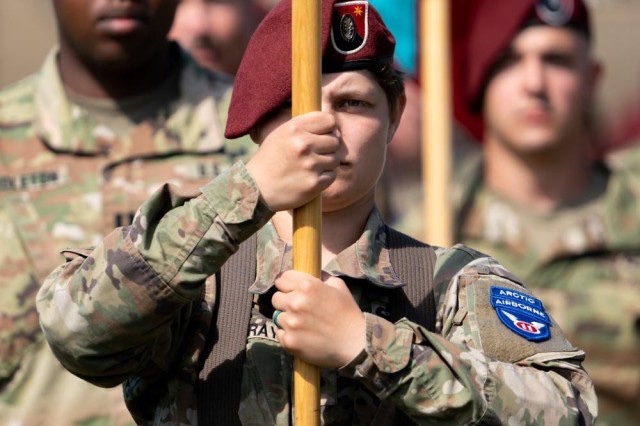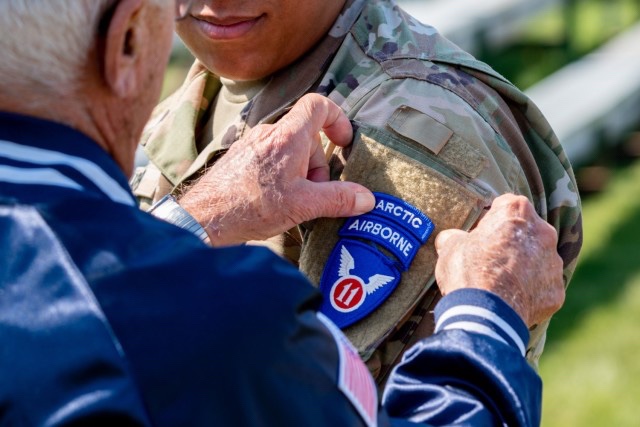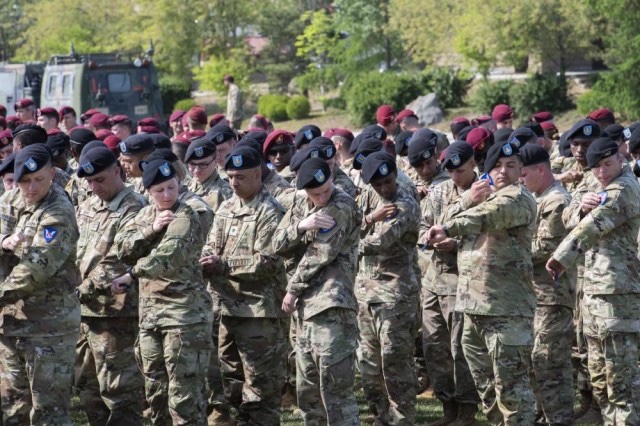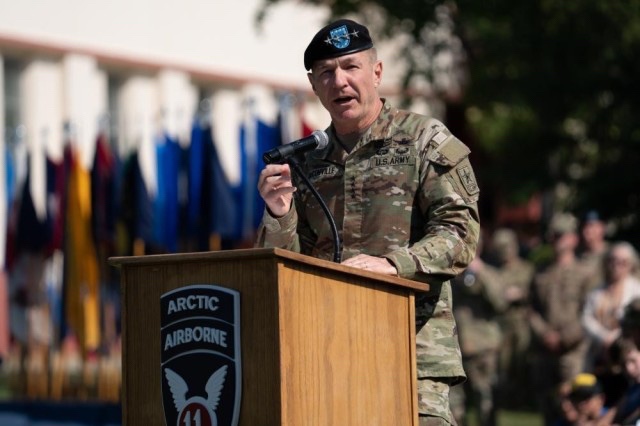
FORT WAINWRIGHT, Alaska – Several hundred Soldiers gathered in formation within the Alaskan Interior on a bright June morning Monday to take part in the activation of the 11th Airborne Division, posturing U.S. forces for strategic advantage in the harsh Arctic terrain.
The 11th Airborne Division unites about 12,000 Soldiers in Alaska under one flag, marking the first time that the Army has activated an airborne division in 70 years. During flag ceremonies Monday at Fort Wainwright and Joint Base Elmendorf-Richardson, shortened as JBER, the Army also re-designated the 1st Stryker Brigade Combat Team and the 4th Infantry Brigade Combat Team, formerly of the 25th Infantry Division, into the 1st and 2nd Infantry Brigade Combat Teams of the 11th Airborne, respectively.
The activation reaffirms the Army’s commitment to its recently announced Arctic Strategy, which outlines the service’s plan to equip, organize and train with partner units to establish military dominance in the region. The division will be headquartered at JBER and members will wear the unit’s distinctive blue patch with a red and white emblem with angel wings to symbolize the unit’s call sign, “Angels.”
“Wherever you go, you will be the most highly trained, disciplined and fit Arctic warfighting unit in the world; ready to fight and win,” Army Chief of Staff, Gen. James C. McConville said to Soldiers at Fort Wainwright. “That is what you will do. That is who you are. We are counting on you.”

(Photo Credit: Photo by U.S. Air Force Senior Airman Patrick Sullivan)

The activation also serves another purpose. By uniting the Army units as one airborne unit, Army leaders hope the activation can ignite a greater a sense of camaraderie and enthusiasm for Soldiers serving in one of the U.S. military’s most remote and desolate locations.
In recent months, the Army’s senior leaders have met with commanders at Alaskan installations to address quality of life concerns of Soldiers. Assessments revealed that the previous unit designations did not support unit cohesion.
“Experience has told us that units that have a common unit identity is a source of pride,” McConville said during a meeting with reporters. “It’s extremely important. And the history of a unit and the patch matter.”
McConville said the Soldiers of the 11th Airborne Division will be equipped with cold weather gear within the next 1 to 2 years. He added that the unit will serve as the Army’s leading experts for Arctic military operations.

McConville said that the Stryker Brigade Combat Team based at Fort Wainwright will transition to become a more mobile, infantry-based brigade combat team bolstered with a stronger air assault capability and the skills to maneuver effectively in extreme cold weather environments.
McConville added that the Army plans to move the armored Strykers out of Alaska by the end of the summer as it continues the acquisition process of Cold Weather, All-Terrain Vehicles or CATVs.
The 11th Airborne Division originally played a critical role during World War II and the Vietnam War. The Army credits the unit with the amphibious assault landing at Luzon, Philippines, and eventually helped secure the liberation of Manila from Japanese forces.
“The 11th Airborne Division has a storied history of valor during World War II in the Pacific and also has a proud history of innovation,” McConville said. “So we expect them to live up to the legacy … We expect them to be masters of their craft in Arctic warfighting and extreme cold weather and high altitude and terrain. We expect them to develop innovative ways of operating in this environment.”
The Army now has a strategically located unit that can quickly deploy to any region, especially those in cold weather climates such as Nepal and India.
“Their focus will be on dismounted and Arctic mobility and capabilities of sustained operation in the Arctic [and] extreme cold weather,” said 11th Airborne Division Commander Maj. Gen. Brian Eifler. “In addition, they will providing those capabilities in other cold weather environments.”
Eifler added that U.S. Army Pacific Commander Gen. Charles A. Flynn traveled to Nepal to meet with Nepalese leaders on coordinating more training opportunities with U.S. Army infantry brigade combat teams. Eifler said that includes the possibility of taking part in a joint expedition on Mount Everest.
By Joe Lacdan, Army News Service


Hey Army, it takes more than a new patch and “renewed focus” to field a competent and capable force to fight in the arctic. It took the 6th ID years to become familiar with operations in arctic environments.
The remnants of the 6th ID became the 172nd Brigade, which became the 1st BCT of the 25th, and has now reflagged to the 11th. It’s virtually the same unit, never left AK, and hasn’t stopped training there. The institutional knowledge still remains within the unit. They didn’t just send two brigades to AK, don patches, and start playing arctic warrior.
Preach it Jon! 🙂
I don’t know why they didn’t just reflag the two brigades the 171st & 172nd. Which both share the Alaska history and the damn patched literally scream ALASKA. And make US Army Alaska a more operational task force HQs similar to SETAF
Common sense plays no role in the Army’s love for reactivating Regimental, and Division Colors. Except for the 18th Airborne Corps which will for the most part only do it when adding brigades (508th PIR for example).
Arc Light!
I was stationed the the 4/327 Inf 172 LIB when we transitioned to the 1/17 Inf 6th ID (L) . They should have never deactivated the 6th. I did more walking after the transition than before.
1-2 years to be equipped with cold weather gear. That doesn’t sound right.
Bill,
NEW – next generation – cold weather gear. The Article left out that one critical word, “new.” There is another article here on SSD somewhere from a few months ago that gave a glimpse at some of the newest generation of extreme cold weather gear that is coming down the pipeline. That and the new CATVs mentioned in the article will enhance soldier survivability and effectiveness as well as ground mobility in Arctic environments.
TLB
This is a reply to Darrin. The 172 LIB was stationed at Ft Richardson and Wainright. The things that changed were , the patch, the addition of I believe a Minnesota based reserve infantry brigade and making us a rdf unit. It didn’t take us years to become proficient at Arctic warfare
aIrB0rNe i$ iRrElEvent
I see some Red Berets in the photo, but no mention of airborne units that would make this the 11th Airborne Division. Also the failure to note the combat jumps made by the division in WWII is curious.